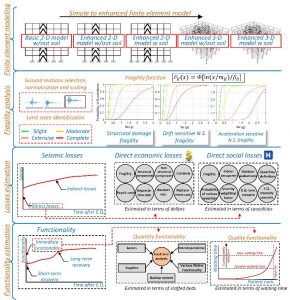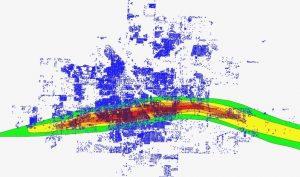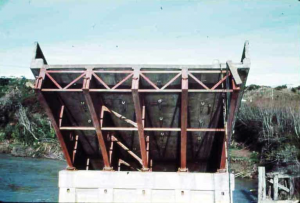Urban Infrastructure Resilience
Damage and loss analysis

Schematic of Modeling, damage, loss, and functionality analysis (Hassan and Mahmoud 2018)
Modeling the recovery process of a community’s infrastructure after the occurrence of extreme events is now at the forefront of research. Estimating post-disaster recovery of either single or multiple infrastructure in a community requires proper flow and interaction of information of the physical, economic and social components of the involved sectors. Different parameters play various roles in the level of functionality restoration or recovery that can be achieved following a major event. The prerequisite information needed to estimate the recovery process is proper assessment of damage and losses incurred. Proper assessment of damage requires the development of proper numerical models that can be used to assess the probability of failure for a give hazard intensity. Consequently, accurate assessment of losses depends on the loss function used in relation to the sustained damage. There have been an amble number of studies pertaining to estimating damage and losses to infrastructure. However, to date, very limited studies have been conducted to assess the effect of modeling approach on seismic fragilities of an infrastructure, the associated losses, and recovery of functionality reduction. In addition, existing framework for estimating functionality of critical infrastructure, such as a hospital, following an extreme event have not considered the interdependent relationship between a hospital and other lifelines. At Colorado state University, studies are being conducted to evaluate the effect of modeling approach on the estimated infrastructure damage and new frameworks are being developed for evaluating functionality of critical infrastructure, such as hospitals following extreme hazards. Relevant studies can be found in the reference list below:
- Hassan, E. and Mahmoud, H. (2018) “A Framework for Estimating Immediate Interdependent Functionality Reduction of a Steel Hospital Following a Seismic Event”, Engineering Structures, Vol. 168, 669–683.
- Hassan, E. and Mahmoud, H. (2017) “Full Functionality and Recovery Assessment Framework for a Hospital Subjected to a Scenario Earthquake Event”, Engineering Structures, Accepted for Publication.
- Hassan, E. and Mahmoud, H. (2017) “Modeling Resolution Effects on the Seismic Response of a Steel Hospital”, Journal of Constructional Steel Research, Vol. 139, 254–271.
- Memari, M, Attary, N., Masoomi, H., Mahmoud, H., van de Lindt, J., Pilkington, S., Ameri, M. (2018) “Minimal Building Fragility Portfolio for Damage Assessment of Communities Subjected to Tornadoes”, ASCE Journal of Structural Engineering, DOI: 10.1061/(ASCE)ST.1943-17 541X.0002047.
J5. Hassan, E. and Mahmoud, H. (2018) “A Framework for Estimating Immediate Interdependent Functionality Reduction of a Steel Hospital Following a Seismic Event”, Engineering Structures, Vol. 168, 669–683. - Hassan, E. and Mahmoud, H. (2017) “Full Functionality and Recovery Assessment Framework for a Hospital Subjected to a Scenario Earthquake Event”, Engineering Structures, Accepted for Publication.
- Hassan, E. and Mahmoud, H. (2017) “Modeling Resolution Effects on the Seismic Response of a Steel Hospital”, Journal of Constructional Steel Research, Vol. 139, 254–271.
- Memari, M, Attary, N., Masoomi, H., Mahmoud, H., van de Lindt, J., Pilkington, S., Ameri, M. (2018) “Minimal Building Fragility Portfolio for Damage Assessment of Communities Subjected to Tornadoes”, ASCE Journal of Structural Engineering, DOI: 10.1061/(ASCE)ST.1943-17 541X.0002047.
Recovery modeling
Following major hazards, prompt response and effective recovery become critical to saving most lives and minimize disastrous impact to the community. Disrupted interdependent infrastructure systems in a community often face hazardous environments rightly after a major hazard. To appropriately model the time-dependent recovery process is a key in order to cover emergency response immediately following hazards, early recovery in the early stage following the hazard and long-term recovery efforts. Several research efforts include:
- Emergency response traffic planning and management of disrupted community
- Adaptive recovery strategy of critical infrastructures considering infrastructure interdependency and disruption;
- Bridge infrastructure long-term renovation planning to maximize the community resilience;
- Integrated traffic and energy response strategy following hurricanes;
- Post-hazard travel time prediction of urban traffic network disrupted by earthquakes.
Climate change impacts on communities
Buildings, bridges and transportation facilities, and other civil infrastructure traditionally have been designed, constructed, operated and under the assumption that time-dependent environmental demands due to wind, snow, flooding and sea level rise, and other environmental factors are stationary in nature, implying that their probabilities of occurrence and intensity used to develop design criteria are time-invariant during their service lives. Advances in climate science strongly suggest that these assumptions are no longer tenable, and that demands are changing from historical values due to anthropogenic activities. As a result uncertainties in probabilities of performance and functionality and risks to communities cannot be ascertained using traditional approaches to civil engineering planning and design, and the likelihood of increasing failure rates within the inventory of civil infrastructure facilities must be considered.
Changing climate is leading to a paradigm shift in civil engineering planning and design. Research in this topical area includes:
- Nonstationary modeling of wind effects, snow loads riverine flooding and sea level rise needed for development of codes and standards and land use planning;
- Examination of the interactions between nonstationary climatological demands and structural deterioration on civil engineering condition assessment and development of cost-effective maintenance policies;
- Life-cycle cost/benefit assessment methods for examining the impact of a changing climate, and its uncertainties, on civil infrastructure over periods of up to 100 years and for identifying dominant contributors to risk;
- Development of methods for intergenerational risk assessment to ensure that investments in risk management are shared fairly between current and future generations.
Risk Assessment and performance-based engineering of physical systems
In contrast to traditional prescriptive design methods, performance-based engineering (PBE) is founded on the premise that structural systems and the nonstructural systems they support, must meet specific performance objectives – life safety, immediate occupancy or functionality following an extreme environmental event, and serviceability under conditions of ordinary use. Some performance goals may be qualitative; others, including goals related to public or occupant safety, must be quantitative in nature to fulfill the primary objectives of building regulation and are expressed probabilistically. PBE offers flexibility and controllability to the engineer in meeting the objectives of the client within a general framework of acceptable practice provided by society.
The performance of civil infrastructure design is demonstrated through analysis, simulation, prototype testing, or a combination thereof. In light of uncertainties in demands from service, environmental and anthropogenic conditions and capacities, and limitations in engineering analysis at the customary scales of modeling, a decision-theoretic approach is recognized as essential to taking full advantage of PBE. Research to support PBE includes:
- Advanced stochastic modeling of uncertainties in service, environmental and geophysical loads in both spatial and temporal domains;
- Stochastic models of performance of building components, subsystems and systems across a spectrum of demands and at context-specific scales, ranging from service-level excitations to disproportionate collapse under accidents to terrorist attack, using both fragilities and non-fragility based methods;
- Models of building inventories and their role in community resilience and functionality assessment, taking into account spatial correlations due to demands and common building practices;
Risk-informed decision criteria consistent with stakeholder preferences using cost optimization, utility theory and other advanced decision frameworks of life-cycle engineering.
Interdependent physical-social-economic modeling and analysis
Community resilience depends on the performance of the built environment and on supporting social, economic and public institutions which, individually and collectively, are essential for the functioning and recovery of a community following a disruptive hazard event. A community’s social needs and objectives (including post-event recovery) are generally not reflected in current codes, standards and other regulatory documents developed for the design of individual facilities and infrastructure systems. Community resilience assessment focuses on the complex inter-dependencies among the physical, social, and economic systems on which a healthy and vibrant community depends and can provide a mechanism to better understand resilience needs relative to natural hazards. Modeling the resilience of communities as an integrated system-of-systems requires numerous disciplines, including engineering, social sciences, and information sciences. The Center of Excellence (CoE) for Community Risk-Based Resilience Planning headquartered in the CEE Department at Colorado State University was established to develop a computational research environment that will advance community resilience modeling and assessment. A number of projects led by the CEE Department at Colorado State University focus on modeling these complex systems at the community level.
Center of Excellence Website:
http://resilience.colostate.edu

Model of an EF5 tornado wind field (red in excess of 200 mph) interacting with more than 30,000 buildings in Joplin, Missouri (John van de Lindt, Bruce Ellingwood, Suren Chen, Gaofeng Jia, Hussam Mahmoud)
Bridges over water
The sketch views a bridge in a way not ordinarily seen by the public. The view is important. It emphasizes the critical role played by the foundation underpinnings of a bridge. Scour-induced collapse of those underpinnings, however, is a common cause of bridge failure. 
Few situations of water flow are potentially more complex than along bridge waterways in which bridge foundations are placed. An old saying reputedly goes – Person who overlooks water under bridge will find bridge under water. Of concern is flow-induced scour of the sediments and soils that form the boundaries of bridge waterways. Water flow approaching and passing through the bridge opening, as well as flow immediately downstream of the bridge opening, may erode and remove (scour) these sediment and soils, and thereby imperil a bridge. The photo shows a bridge failed owing to pier scour.
 We study all aspects of bridges and bridge waterways. A current study involves scour of waterways contracted by a series of bridges. A recent publication reviews current knowledge about scour at bridge piers:
We study all aspects of bridges and bridge waterways. A current study involves scour of waterways contracted by a series of bridges. A recent publication reviews current knowledge about scour at bridge piers:
https://ascelibrary.org/doi/10.1061/%28ASCE%29HY.1943-7900.0001330